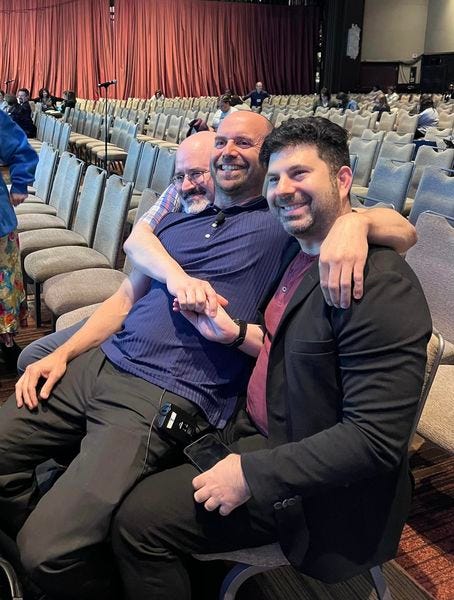The Great Disconnect: Why We Lose Touch and How to Rekindle Old Friendships
Some Scary and Hopeful New Scientific Research
This is part of a series on loneliness including mistaken ideas and the lifestyles of lonely people and breaking up with friends. Get the full archives with 100+ posts and regular Q&A with me on these topics by becoming a paid subscriber.
In this my 49th year on Earth, I counted the number of contacts on my smartphone - 529. With great hesitation, I then counted how many of them I texted or called in the past year: 86. That is, I am only interacting with 16.3% of the people who I cared enough about to keep their digits close. I’ll let you decide whether that’s acceptable. For me, a hypomanic, extraverted character, I’m surprised. What’s happening to our close relationships? Am I an outlier? If there is a problem, what are we doing about it?
Much has been written about loneliness and friendship (The Atlantic cranks out related articles - one, two, three, and four). Of great emphasis is the constantly shrinking number of close friendships by women and even more so, men.

It is worth perseverating on when this happens and why. For instance, college serves as a psychological intervention in at least two interesting ways. Graduates experience:
a massive decline in problematic drinking and drug use
A drop in face-to-face contact with such a large number of friendships (on average - individual results vary)
Dissecting Friendship Decay
Imagine your social network as an onion, each layer representing the different circles of your friendships. At the core, you have your deepest, meaningful friendships, the ones you'd confide secrets to and call to help bury the bodies. This is your inner circle, typically comprising ~5 individuals. This group can include family members, childhood buddies, or your other half. Scientists find that this innermost group occupies about 40% of your social time and attention. Which is great because this means you are discerning - and know who is most valued (see my thoughts on these Emotionships - here).
Peeling back the next layer, we encounter about 15 of your close friends, followed by a broader circle of 50 friends. Lastly, the outermost layer, a network of approximately 150 acquaintances or what we might term generic friends. Each layer signifies a unique level of emotional closeness and commitment, with the inner circles forming the core of your identity. For a deeper exploration into the fascinating realm of friendships, delve into the latest book by renowned friendship researcher, Robin Dunbar - here.
Interestingly, this layered structure is not just confined to offline, face-to-face networks. It's also observed in online social media networks like Facebook and Snapchat, and even multiplayer online games.
Now, these layers aren't static. Friends can move between layers, or even drop out of the onion altogether. And the size of these layers change over time, usually growing in our younger years and stabilizing as we age.
Recent research has zoomed in on the core of the onion - the inner circle. We're curious to know more about these closest of relationships in our social networks.
The Mega Study on Friendship Decay
Let's dive into the ultimate study on "Turnover in Close Friendships." Researchers examined the mobile phone records of 644,170 people over a span of three years. That's a whopping 1,143,718 connections among users! How did they define inner circles? By the sheer volume of incoming and outgoing calls and texts. All this data was gathered to answer two burning questions:
1. What percentage of relationships drop out of the inner circle?
2. Who's more likely to face the music of friendship fallout?
The revelations?
Our inner circles are as steady as rocks. Only a tiny 1-4% of people in the inner circle are excised over the course of three years.
For friendships between men and women, there's a double gain in inner circle members compared to losses. But here's the kicker - the "decay" rate, or the losing-more-friends-than-you-gain scenario, is higher for young adults (17-21 years) than for adults aged between 25 and 55 years.
What’s fascinating is that the results question common beliefs that older adults show greater stability in their mood and relationships compared to the flux of youth. Maybe there is a need for a reverse transfer of wisdom. Where college aged adults who are often bemoaned as fragile, impulsive, and unmoored explain what they do to keep important friendships paramount.
The intellectually humble recognize that wisdom might arise from surprisingly places and it’s worthwhile to remain open to any opportunity
Friendships, much like houseplants, need constant care and attention. Neglecting to water them, or moving them to a new environment, can cause them to wilt. Similarly, friendships can fade when we graduate to a new phase of life, relocate to a different city, or simply evolve in our values and personality.
Just as you wouldn't toss out a wilting plant, old, high-quality friendships too can be revived with a little effort.
Attempts at Reconnection
Humans are weird. Friendships are like comfort food - warm, familiar, and soothing. But when it comes to reigniting the flame with old friends, we're surprisingly hesitant. It's as if we're standing outside a locked door, keyless, and instead of knocking, we're shuffling our feet. To solve this mystery as to why, we can turn to a set of 7 studies conducted by Drs. Lara Aknin and Gillian Sandstrom.
They started by casting a wide net, asking how many people lost touch with a friend they cared about? The answer:
90.9%
Asked if they are willing to reach out to these beloved characters, they didn’t say yes, they didn’t say no, they were neutral, uncaring, ambivalent. Pretty weird that they felt almost nothing. Or rather, reported feeling almost nothing - which is hard to believe and likely a bit of dissonance in action.
When asked about the desire to reach out to this old friend, the researchers compared this desire to 7 other activities. Want to know how unappealing it isto contact a friend you lost touch with?
When asked, adults said they’d rather eat an ice cream bar.
They’d rather experience the pain of a lengthy, painful handgrip.
They’d rather talk with a stranger!
In fact, the only thing deemed less desirable than reaching out to an old friend?
Scheduling a dentist appointment.
Spending the day sorting coins.
Humans are fucking weird.
Researchers attempted to initiate reconnection with a first step. They provided adults an opportunity to message long-lost friends, allocating a few minutes to send a quick text. Yet, the response to this opportunity was lukewarm. Despite their best cheerleading attempts, only around 30% of the 1,000 participants sent messages.
The reasons? Participants expressed concerns about finding the right words or facing a friend who had drastically changed over time. It seemed that old friends, over time, had morphed into intimidating strangers. The more a former friend felt like a stranger, the less likely participants were to reach out.
While there's much more to explore, one key takeaway is clear: people do care about their old friends, but they grapple with the anxiety of rekindling these connections.
Provocations
There are a few clear barriers to reconnecting with meaningful people in our lives spanning anxious expectations, a mismatch between what we want and what we do, and an asymmetry between what we think people will feel if we contact them and what actually happens.
So the question is - can you take the leap, right now, and reach out with a short text/email/call to someone on that smartphone contact list who has been neglected for too long?
Dennis Tirch and Juliana Read, expect a text after I send this off.
Extra Curiosities
If you are interested in a deep, comprehensive exploration into what we know about increasing our sense of agency and empowerment then read the latest book by Dr. Emma Seppala: Sovereign: Reclaim Your Freedom, Energy, and Power in a Time of Distraction, Uncertainty, and Chaos. She is the ultimate curator of useful science. Don’t be scared off by a title that you can’t spell. Emma connects the dots among all those concepts rolling around: belonging, psychological safety, burnout, imposter syndrome, self-determination, meaning in life, resilience, etc. We need more synthesizers. This is it.
Todd B. Kashdan is an author of several books including The Upside of Your Dark Side (Penguin) and The Art of Insubordination: How to Dissent and Defy Effectively (Avery/Penguin) and Professor of Psychology and Leader of The Well-Being Laboratory at George Mason University.
Read Past Issues Here Including:
What Kurt Vonnegut Taught Me About Mental Restoration
In a whirlwind of intellectual activity, I found myself sharing a panel with two of the foremost creativity researchers. Our topic? How does one bring more humanity into an education system grappling with AI. An hour later, I was leading a workshop to equip youth with












